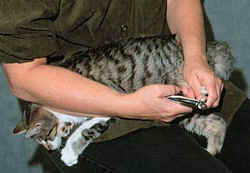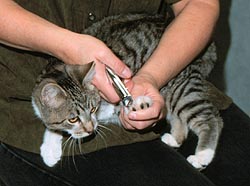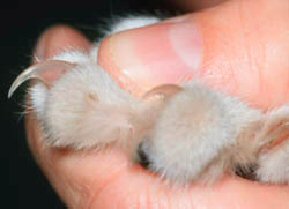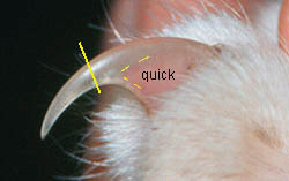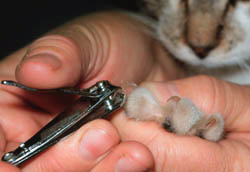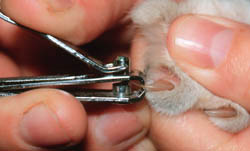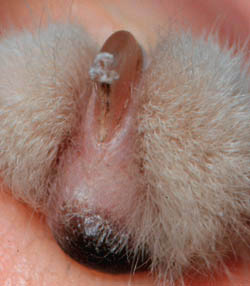
ANIMAL RESCUE AND ADOPTION TEAM INC.
How to Give a Cat a Manicure

This information is not meant to be a substitute for veterinary care.
Always follow the instructions provided by your veterinarian.
In the photographs below, unless otherwise noted, the top if the paw is facing up. Variations on these instructions exist.
Clipping your cat’s claws really makes a difference. If claws are kept blunt, a cat that strays from the scratching post from time to time will do little to no damage. You can get results without painful and mutilating declaw surgery by cutting the nails every two to six weeks (long toenails can grow into the toe pad).
- Handle your cat’s paws regularly when he’s relaxed. Massaging his paws and separating the toes will help him be more relaxed when it’s time to clip the claws.
- Make sure there is enough light. Having the cat’s paw between the source of light and yourself makes it much easier to see where to cut.
- Ask someone to help you. While one person holds, the helper can do the actual clipping.
- Get your cat alone. This is especially important in a multi-cat household. Choose a time when your cat is calm – naptime may be the best. Some find it best to schedule the manicure after a meal. If the cat is groggy from an after-dinner snooze she’ll be more relaxed and easier to handle.
- If your cat is not in favor of claw clipping, start slowly. Make it pleasant. Initially, do only a few nails at a time. Clip as many as you can, then praise your cat and offer a treat or scratch the cat in his favorite spot; then let him go.
- Don’t expect to clip all ten front nails at once. Turning the event into a struggle will only make future sessions more difficult. Success is often measured in small amounts, so if you only clip one claw a day, it may be a successful day!
- Until you and your cat are comfortable with clipping, just take off the tiniest tip, ensuring you don’t get the quick.
- There are several styles of nail trimmers, including a scissors cut and a human fingernail clipper. A pair of sharp, well-made cat nail scissors is the tool of choice. Other equipment can do the job, but a pair of scissors is the easiest to grasp when holding a squirming bundle of cat.
- If you do not succeed, take your cat to a veterinarian who can help you out.
- PetSmart and PETCO also provide affordable cat nail trimming services.
MOST CATS DO NOT LIKE HAVING THEIR CLAWS TRIMMED
Some cats will happily sit in your lap or on a table while you trim their claws but many require some form of restraint.
More is NOT better. Work with the cat in the position that he finds most comfortable yet provides you adequate exposure to do what you need to do.
The LEAST amount of restraint that is needed should be applied. Excessive restraint becomes a test of wills and you will find cats to be stubborn and not give up. The more you attempt to restrain them, the harder they resist and the less pleasant and more dangerous the experience becomes for all.
To restrain a cat in your lap, use your forearms draped over the cat’s neck and hind-end to keep the cat in your lap. The clipper is held in the right hand.
PRESS THE TOE TO EXPOSE THE NAIL
Cats have retractile claws so you need to gently squeeze the toe between thumb and index finger and gently press to expose the claw so it is pushed out and easy to see.
LEAVE ABOUT 1/8” OF NAIL IN FRONT OF THE QUICK
Most cats have light colored toenails, making it easy to see the blood vessels and nerves that supply the toenail as a pink stripe at the base of the nail, which is called a quick. You want to cut the toenail to within approx 1/8” of the quick.
Over time, the quick of the nail recedes if the nails are clipped regularly, allowing the nail to be clipped shorter, to a blunter tip.
If you cut into the quick, your cat will experience pain and may give a cry and try to pull away from you. You may observe a small bit of blood on the end of the nail. Wipe the blood away with a tissue or paper towel. You can use styptic pencil containing silver nitrate to stop blood flow, although many animals object to the styptic pencil as much, or more, than claw cutting. The black end of the stick is held to the bleeding nail and gently rotated.
Even without any treatment the nail should stop bleeding in about 5 minutes or less. In the future, just cut the nails a little further away from the quick.
REMEMBER TO TRIM THE DEW CLAW
Cats have a nail on the inner side of each foot called the dew claw. Remember to trim these as they are not worn down when the cat scratches and can grow in a circle, growing into the foot.
CORRECT PLACEMENT HUMAN NAIL TRIMMER
The clipper should be placed perpendicular to the nail (cutting top to bottom).
INCORRECT PLACEMENT HUMAN NAIL TRIMMER
If the trimmer is placed parallel to the nail (cutting from side to side), the nail is crushed and may splinter.
THE SHARPER THE TRIMMER, THE CLEANER THE CUT.
You can use a nail file to smooth the end of the nail after clipping.
HEART Animal Rescue & Adoption Team Inc. assumes no liability for injury to you or your pet incurred by following these descriptions or procedures.
 Heart Animal Rescue and Adoption Team Inc.
Heart Animal Rescue and Adoption Team Inc.
6580 Gowanda State Road, Hamburg
Hamburg, NY 14075
Phone: 716-821-1915
©2018 HEART Animal Rescue and Adoption Team Inc.
All rights reserved - No text or images can be used from this site without permission
Website Hosting provided by SM Digital Creations - 716-254-6130.



